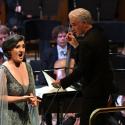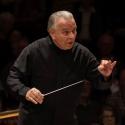“Next he’ll be walking on water,” allegedly quipped a distinguished figure at the official opening of Simon Rattle’s new era at the helm of the London Symphony Orchestra. Well, last night, with no celebratory overload around the main event, the homecomer was flying like a firebird, and taking a newly galvanised orchestra with him, at the start of another genuine spectacular. And that's no exaggeration, for how often, if ever, have you encountered all three of Stravinsky’s biggest, and earliest, ballets in a single concert?
This journey from the compendium-salute to the Russian romantic tradition which put Stravinsky on the map in 1910 to the dawn of another age in sound and rhythm within three years – in Petrushka every inch as much as The Rite of Spring – was so exhilarating that by the celebratory end of The Firebird you were delirious with anticipation of the second and third acts.
Players were prepared to go the extra mile as singer-actors in three operas without words
Gone were all the peripheral sound and vision reported in the opening concert – though, to be honest, it wouldn’t harm the LSO to adopt the Philharmonia’s principle of supertitles to describe the myriad choreographic score-indications, especially in the mimetic stretches of the complete Firebird. This time the focus was entirely on Rattle’s seemingly healthy relationship with players prepared to go the extra mile as singer-actors in three operas without words. His gestures were compact and often minimal, despite plenty of fierce ogre-faces; if only he'd apply this rigour, plus a bit of the freedom he sometimes lacks, to late-romantic scores, still an Achilles Heel.
What personality there was in the playing. I’d never noticed quite how brilliantly and definitely violinist Roman Simovic co-leads from the front desk with Carmine Lauri; their warm embrace at the end of the epic spoke volumes. It was strange that Rattle only gave selective post-Firebird stand-ups: though Timothy Jones’ horn solo as the Prince in Kashchey’s enchanted garden falls in love with the lead Princess was every inch as nuanced as the great folksong solo ushering in the day, oboist Olivier Stankiewicz and flautist Gareth Davies proved equally outstanding. The colours, as always with Rattle (pictured below by Doug Peters/PA Wire), were fine-tuned, but I wasn’t expecting quite that depth of emotion in the triumph of good over evil; what used to be four pianissimos in the string tremolos before the dawn in his CBSO interpretation now became at least five, ppppp, no easy task in the Barbican. Petrushka plunged us into a pell-mell fairground that was at the same time razor-sharp, strings no second fiddle as crowd and giant accordion to the many songs of wind and brass, never more luridly brilliant than in this performance. It might have been tempting to bring in a famous pianist for the Rattlethon as the concertante figure in manic-depressive Petrushka’s booth, but Philip Moore knew exactly how to advance and retreat in tandem with the semitonal clarinets – first lugubriously peering, then fierce – and there were opportunities for all brilliantly taken, not least by Ross Knight’s bear lumbering to Chi-Yu Mo’s E flat piping. This was a tough evening for the brass, and you could forgive a few rough edges, but Philip Cobb held his nerve leading Petrushka’s ghost along the roof. Details again fine-tuned, down to the softest final pizzicato in the four notes which so dissatisfied Diaghilev – what, no flourish to bring down the house? – but which worked so well between the massive endings of the outer-panel ballets.
Petrushka plunged us into a pell-mell fairground that was at the same time razor-sharp, strings no second fiddle as crowd and giant accordion to the many songs of wind and brass, never more luridly brilliant than in this performance. It might have been tempting to bring in a famous pianist for the Rattlethon as the concertante figure in manic-depressive Petrushka’s booth, but Philip Moore knew exactly how to advance and retreat in tandem with the semitonal clarinets – first lugubriously peering, then fierce – and there were opportunities for all brilliantly taken, not least by Ross Knight’s bear lumbering to Chi-Yu Mo’s E flat piping. This was a tough evening for the brass, and you could forgive a few rough edges, but Philip Cobb held his nerve leading Petrushka’s ghost along the roof. Details again fine-tuned, down to the softest final pizzicato in the four notes which so dissatisfied Diaghilev – what, no flourish to bring down the house? – but which worked so well between the massive endings of the outer-panel ballets.
Is Rattle’s – are everyone else’s – Rite(s) of Spring too well known by now? It’s true that there are few of the interpretative idiosyncrasies which make one sit up and listen afresh from the likes of crazy Teodor Currentzis (check out an astonishing new recording with his Russian orchestra). It might also be more rewarding to have every song in the work – and there are many – phrased as individually and beautifully as Rachel Gough’s bassoon at the start, given total freedom, or the string groups in the atmospheric, jungly introduction to Part Two (muted trumpets sounding as if offstage always a Rattle speciality).
Yet none of the climaxes failed to hit its focused target; even if a colleague found much of it “too slow”, the point is that highest energy, which the LSO still somehow found in the third part of an exhausting evening, will always fill the spaces. The polyrhythms at the height of “Procession of the Sage”, a “Glorification of the Chosen One” which hit this listener right in the gut, and tireless horns gilding the “Sacrificial Dance” all struck afresh. I only hope more folk tune in to the YouTube livestream of Sunday’s repeat performance than apparently did for the Berlioz; and that children and teenagers everywhere – not enough of them in last night’s audience – get the Stravinsky bug from watching. If Rattle can simply engage a new generation in some live-wire music-making, his appointment will have been worth its salt for that alone.
- Broadcast on BBC Radio 3; listen for the next month on the BBC iPlayer
- Sunday's repeat performance sold out; watch the live stream
- Read more classical music reviews on theartsdesk














Add comment